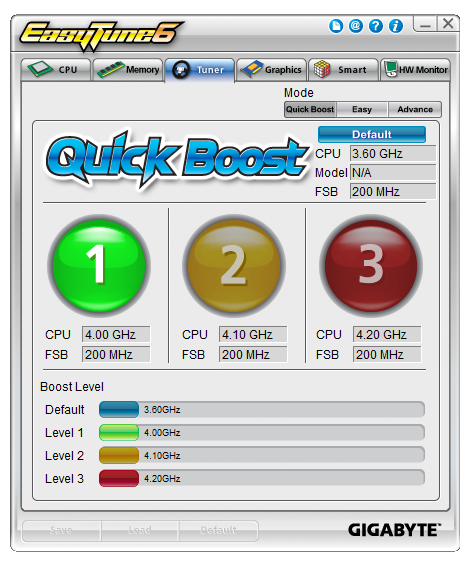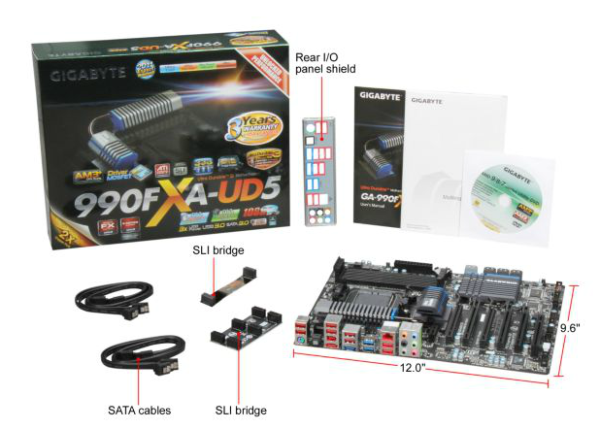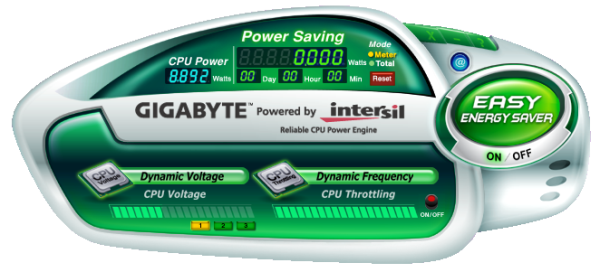990FX Motherboard Roundup with Thuban and Bulldozer – A Second Wind for ASUS, Gigabyte, MSI and Biostar
by Ian Cutress on April 5, 2012 11:00 AM ESTGigabyte 990FXA-UD5 In The Box
Gigabyte packages of late have often been criticized for being bleak and uninteresting. This is typically because Gigabyte employ the model of trying to hit the price point for as cheaply as possible – the extra kit in the box costs, and if Gigabyte can hit a channel board in the next price bracket down, they feel it is beneficial to the consumer. With that being said, this bundle has:
Driver CD
User’s Manual
IO Shield
4 x locking SATA cables
3-way fixed SLI bridge
A long non-fixed SLI bridge
Image Courtesy of Newegg
Board Features
| Gigabyte 990FXA-UD5 | |
| Price | Link to Newegg |
| Size | ATX |
| CPU Interface | AM3+ |
| CPU Support | AMD FX/Phenom II/Athlon II |
| Chipset | AMD 990FX |
| Base Clock Frequency | Auto, 200 MHz to 500 Mhz |
| Core Voltage | Normal, -600 mV to +600 mV |
| CPU Clock Multiplier | Auto, x7 to x35 |
| DRAM Voltage | Normal, 1.025 V to 2.135 V |
| DRAM Command Rate | Auto, 1T or 2T |
| Memory Slots |
Four DDR3 DIMM slots supporting up to 32 GB Up to Dual Channel Support for DDR3, 1066-2000 MHz, |
| Expansion Slots |
3 x PCIe Gen2 x16 (x16/x16 or x16/x8/x8) 2 x PCIe Gen2 x4 1 x PCIe Gen2 x1 1 x PCI |
| Onboard SATA/RAID |
6 x SATA 6 Gbps, Support for RAID 0, 1, 5, 10 2 x SATA 6 Gbps, Support for RAID 0, 1 (Marvell 88SE9172) 2 x eSATA 6 Gbps |
| Onboard |
8 x SATA 6 Gbps (6 SB950, 2 Controller) 4 x Fan Headers 1 x Front Panel Header 1 x S/PDIF Output Header 3 x USB 2.0 Headers 1 x USB 3.0 Headers 1 x IEEE1394 Header 1 x Serial Port Header 1 x Clear CMOS Header 1 x TPM Header |
| Onboard LAN | Realtek 8111E |
| Onboard Audio | Realtek ALC889 |
| Power Connectors |
1 x 24-pin ATX connector 1 x 8-pin 12V connector |
| Fan Headers |
1 x CPU Fan Header 2 x SYS Fan Headers 1 x PWR Fan Headers |
| IO Panel |
1 x Keyboard/Mouse PS2 Port 1 x Optical SPDIF Output 2 x eSATA 3 Gbps 1 x Gigabit Ethernet 2 x USB 3.0 8 x USB 2.0 Audio Outputs |
| BIOS Version | F7h |
| Warranty Period | 3 Years |
To keep costs down Gigabyte has gone with a Realtek Audio/NIC combination which is often sold to manufacturers at a discount as a combo. As always, Gigabyte has included a TPM module header on board for those that require that functionality. What Gigabyte tend to skip out on is a pair of power/reset buttons, or onboard Clear CMOS button rather than pins. I would like to see those rolled out over the range if at all possible.
Software
Where certain other manufacturers have increased and improved their software over the years, Gigabyte has essentially kept to the same set of software for a good while with minimal updates. If you discount the 3D BIOS offerings of X79, all we have to play with is, for the most part, EasyTune – Gigabyte’s monitoring and overclocking center.
EasyTune6
EasyTune takes on a slightly different look if you use a Thuban processor or a Bulldozer processor, especially when it comes to overclocking. The Thuban does not get a set of easy overclock buttons:

In terms of functionality, there is not much we have not seen before from previous Gigabyte outings. Overclocking is done via the base frequency or the multiplier (and depending on the processor, this may work or not as the case may be), and fan controls are a major issue when it comes to Gigabyte products:

From the operating system, this is all we get for fan control of all the controllable headers on board – one little graph with two points. This is rather disappointing, especially when other manufacturers splash out on some more expensive fan headers to get the control in the hands of the user (and then put in the software to back it up).
As EasyTune also features a hardware monitor which polls the various sensors on board for voltages and temperatures every three seconds, this caused issue with a little of our testing, especially in our DPC test. These sensor readings take CPU priority, and hence the DPC results were often 20x bigger than would be reasonable for performing audio on the board with any degree of accuracy. There is a simple solution though – just close ET6.
@BIOS
Gigabyte also has a tool for updating the BIOS. It does exactly what it says on the tin, and is needed from time to time if a big enough change is performed from BIOS version to BIOS version.

Easy Energy Saver
In an effort to appear ‘green’, motherboard vendors are now applying software to their products in an effort to reduce the carbon footprint of the motherboard. In the simplest terms, these software packages attempt to reduce the voltage of the processor at all the load states in order to save energy. The more intelligent systems will also look at other components to save energy, either by power gating through software, or adjusting operational voltages. This is all at the limit on the processor you have at hand (as some will work happily at lower voltages), and at the potential expense of stability. For Gigabyte, this comes in the form of Easy Energy Saver:
Using the ‘intelligent’ driver MOSFETs onboard, they can be controlled and the CPU can be throttled to save power. As a person interested in stability and performance, personally I would shun away from these types of software, but for the more energy conscious, they are here to be used.












57 Comments
View All Comments
fredisdead - Saturday, April 7, 2012 - link
The design of bulldozer/ interlagos is aimed at the server market, where it has absolutely smoked intel the last few months.That said, these are suspiciously skewed benchmarks. Have a look here for a better representation of how bulldozer really performs.
http://www.phoronix.com/scan.php?page=article&...
It's pretty simple really, AMD used the chip real estate to double the number of cores, vs using it on less, but more powerful cores. Seeing that a single bulldozer core appears to have about 80% of the performance of an intel i5 core, looks like a good trade off. For highly threaded applications, its a complete win, and they are doing it on less advanced geometry.
That said, AMD's main product in the consumer space isn't bulldozer, it's llano, and thats looking like a rather large success too.
Oscarcharliezulu - Saturday, April 7, 2012 - link
Nicely written review Ian, was a pleasure to read. I like to hear subjective impressions as well as the facts and figures.Looking at an upgrade I thought to support AMD this time around. The boards seem very well featured for the price compared to intel (though they are catching up) and provide good sata3 and USB support. The problem is the BD cpu's run hot, slow and old software won't run well on it compared to older thubans.
My question- is AMD looking to provide support for more than 4 dimm sockets so we can run large amounts of ram in the future?
quanta - Tuesday, April 10, 2012 - link
Ironically, the A70M/A75 'Hudson' chips, which are designed for the non-FX CPU, actually has built-in USB 3 support that even SB950 doesn't have! The 9-series is supposed to be the enthusiast choice, how can AMD dropped the ball even BEFORE it can pick it up? Compare to the CPU that AMD has designed and built, the I/O support chip design is simple, yet AMD can't even get USB 3.0 and PCI Express 3 to at least relieving some performance bottleneck. If AMD can't even get the chip set right, there is no way in silicon hell for AMD to keep its dwindling fan base, at ANY price/performance bracket.primonatron - Thursday, April 12, 2012 - link
That audio chip on the ASUS ROG motherboard IS a Realtek one. They just allow the installation of a X-Fi utility on top for sound effects.You can see the realtek drivers are required on the ASUS website, but an X-Fi utility is also provided.
Marketing hogwash. :(
http://www.asus.com/Motherboards/AMD_AM3Plus/Cross...
cocoviper - Thursday, April 19, 2012 - link
I'm not defining $240 as the limit for Enthusiast CPUs, I'm saying AMD doesn't have any CPUs that are competitive above that price-point.What the category is called is semantics. We could break the entire line into 100 different categories and it wouldn't change the fact that AMD doesn't have any consumer CPUs in the top 3/4 of the market.
I wasn't quoting Anand like he what he says is law or something, I was noting AMD's strategy day where getting out of the high end market was discussed.
Don't you believe AMD, and ultimately all of us as consumers are at a disadvantage if AMD's best product is capped at $250 or so, leaving $250-up-to-however much Intel wants to charge all their domain? How would you feel if the Radeon series only had products in the lower 25% of the $0-$700 Videocard market? Does the best Radeon being capped at $175 seem like it would keep Nvidia competitive in performance and price?
cocoviper - Thursday, April 19, 2012 - link
Isn't arguing about what price-point defines enthusiast the very definition of semantics? Why don't we just make all processors enthusiast, regardless of price. There AMD and Intel now both make enthusiast processors.To return to the point, Intel's enthusiast processors are the only ones occupying the top 3/4 of the market in cost to end customers. Cost is determined by the market; what people will and will not buy. This is why AMD just announced a price cut on the 7000 series to account for the Kepler launch. Competitive performance and prices keep all suppliers in the market in check, and the end consumer benefits.
The point is AMD is ceding the top 3/4 of the market, and even if they make $200 "enthusiast" processors, Intel is free to charge whatever they like to people that need or want high-end performance. This is bad for all of us, and lame on AMD's part.
menlg21p - Wednesday, March 20, 2013 - link
I made a mistake of installing network genie, and it doesn't show up in my programs and features. I cannot uninstall this program. There is no option for execution on startup. So it always starts up on boot. And there is nothing in the directories that pertain to uninstall. Also no online-content about this feature. Ugh, MSI, what are you doing? Why did you suggest this "crap" on my driver disk. REALLY?